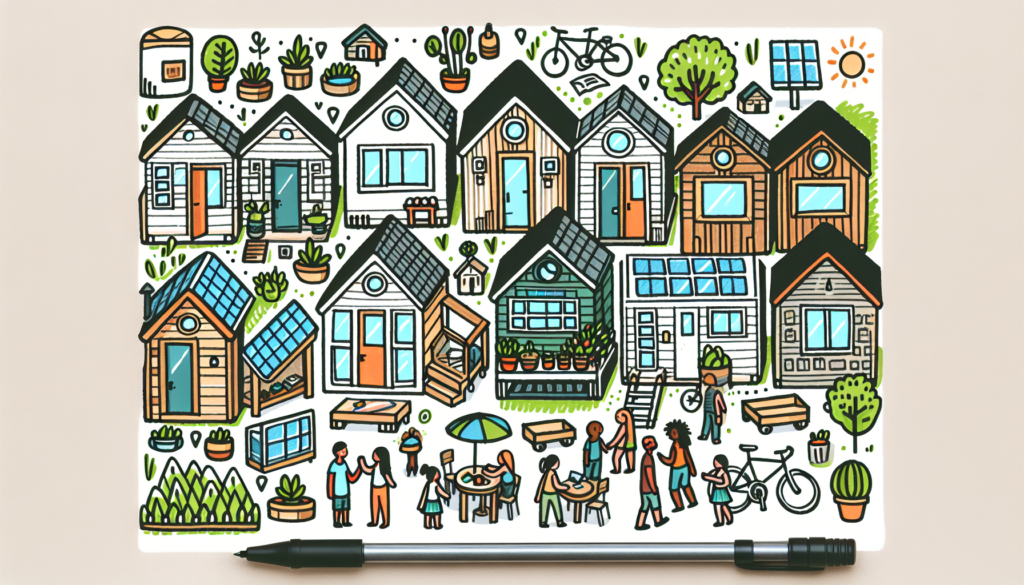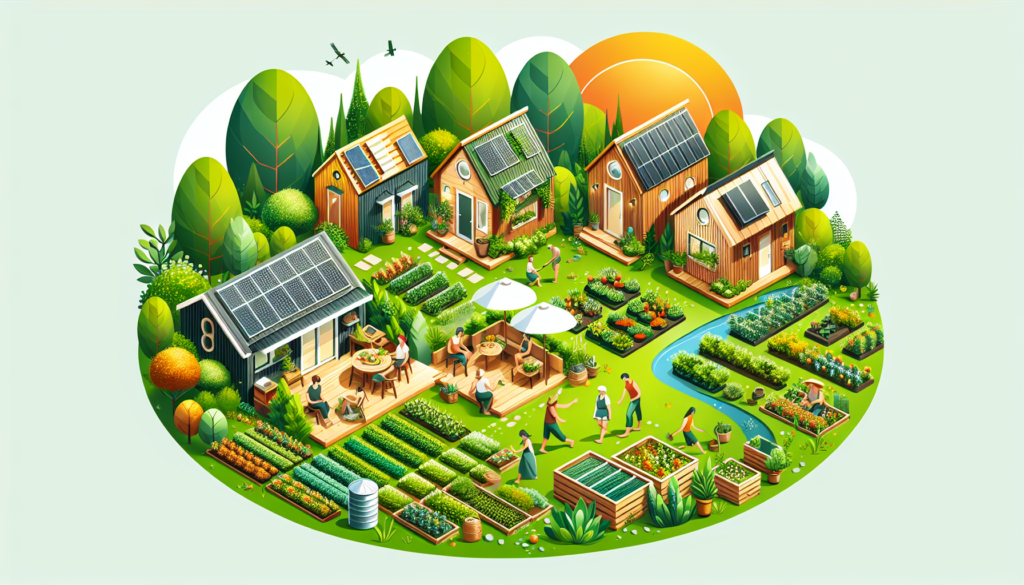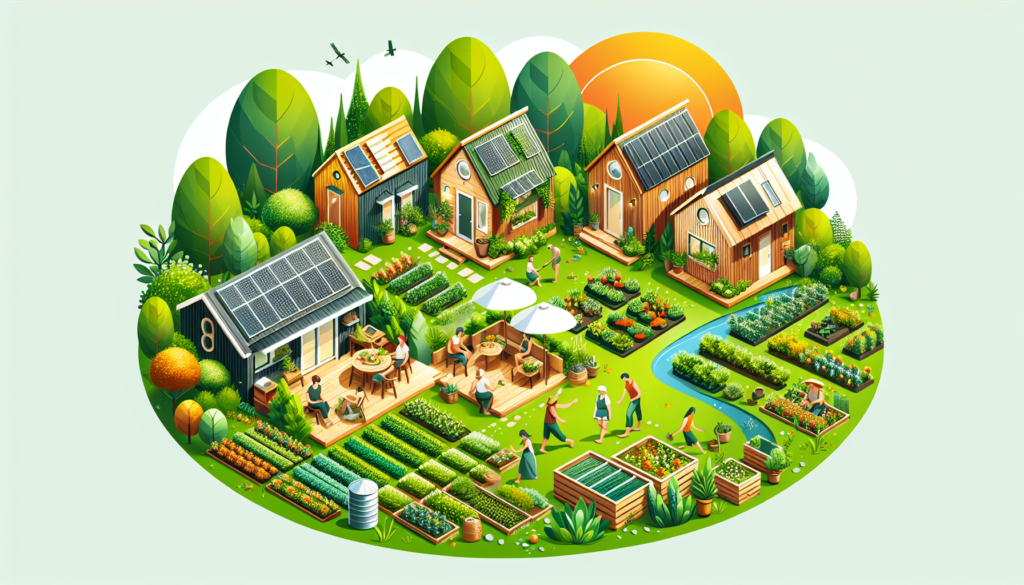Living in a tiny home community can offer a multitude of benefits, from cost savings to a stronger sense of community. By choosing to embrace this alternative lifestyle, you can experience the freedom of living with less, while also fostering meaningful connections with like-minded individuals. In this article, you will explore the advantages of tiny home community living and discover why it has become a popular choice for those seeking a simpler and more sustainable way of life. Get ready to open your mind to a world of possibilities and uncover the joys of tiny home living within a vibrant community. Tiny home living has gained popularity in recent years, and for good reason. The benefits of living in a tiny home community are numerous, ranging from affordability and cost savings to a connection with nature and enhanced social interactions. In this article, we will explore these benefits in detail, highlighting how tiny home community living can improve your quality of life and provide a unique and fulfilling experience.
Affordability and Cost Savings
One of the most significant advantages of tiny home community living is the affordability it offers. Tiny homes have a much lower initial cost compared to traditional houses, making homeownership more accessible. With smaller living spaces, the cost of construction or purchase, as well as maintenance and utilities, is significantly reduced. This allows individuals to save a substantial amount of money on housing expenses.
In addition to lower initial costs, tiny home living also translates into reduced monthly expenses. With a smaller space to heat, cool, and furnish, energy consumption is significantly lower. This leads to lower utility bills, ultimately resulting in substantial savings over time. Moreover, the absence of property tax, which is usually based on the value of a property, further contributes to the cost savings associated with tiny home living.
Sustainable and Eco-Friendly Lifestyle
Living in a tiny home community promotes a sustainable and eco-friendly lifestyle. The smaller size of tiny homes inherently encourages reduced energy consumption. Heating or cooling a smaller space requires less energy, thus reducing the overall environmental impact. Additionally, the use of energy-efficient appliances and renewable energy sources, such as solar power, can be more easily implemented in tiny homes.
Furthermore, tiny homes contribute to lower material and resource usage. With limited space, individuals are forced to think critically about their consumption and make more mindful choices. This can lead to a reduction in waste and a more sustainable approach to living. Additionally, tiny home communities often prioritize sustainable practices, such as composting, rainwater harvesting, and the use of recycled materials, further minimizing environmental impact.

Sense of Community and Support
One of the most appealing aspects of tiny home community living is the strong sense of community and support that it offers. Living in close proximity to your neighbors creates a unique opportunity for collaboration and meaningful interactions. Tiny home communities often provide shared spaces and resources, such as communal gardens, laundry facilities, and community centers. These shared spaces foster a sense of belonging and encourage residents to engage with one another.
In a tiny home community, residents often face similar challenges and experiences, providing a strong foundation for emotional and social support. Collaborative problem-solving becomes commonplace, as residents work together to overcome obstacles and share resources. This sense of community can greatly enhance one’s overall well-being and quality of life.
Minimalistic and Clutter-Free Living
Tiny home living promotes a minimalistic and clutter-free lifestyle. With limited space, individuals are forced to simplify their possessions and prioritize what truly matters. This can lead to a greater sense of simplicity and organization, reducing the stress and burden associated with excess belongings.
In addition to the physical aspect of minimalistic living, tiny home communities often foster a culture of reduced materialism and consumerism. Residents focus on experiences over possessions, valuing personal growth and meaningful connections over the accumulation of material goods. This shift in mindset can lead to a more fulfilling and purpose-driven life.

Flexibility and Mobility
Living in a tiny home community offers a level of flexibility and mobility that traditional housing cannot provide. The compact size of tiny homes allows for easy relocation and the freedom to choose different locations without the burden of uprooting an entire household. This flexibility is particularly appealing for individuals who enjoy traveling or those who prioritize being close to nature.
Furthermore, the mobility of tiny homes is not limited by traditional housing constraints. With a tiny home on wheels, individuals can explore different areas, live off-grid, or even embark on an adventure-filled journey while still having the comforts of home. This level of flexibility and mobility opens up a world of possibilities and allows individuals to live life on their own terms.
Connection with Nature
Tiny home communities often prioritize a connection with nature, providing residents with access to outdoor spaces and promoting an outdoor-oriented lifestyle. With shared gardens, parks, and green spaces, residents have ample opportunities for outdoor activities and a deeper connection with the natural environment.
Living in close proximity to nature has numerous benefits for overall well-being. Spending time outdoors has been linked to reduced stress levels, improved mental health, and increased physical activity. In a tiny home community, individuals have more time and opportunities to enjoy nature, whether it’s gardening, hiking, or simply appreciating the beauty of the surrounding natural landscapes.
Enhanced Social Interactions
Living in a tiny home community encourages enhanced social interactions and the development of stronger bonds with neighbors. With shared spaces and a common sense of purpose, residents naturally engage in collaborative activities and events. This fosters a strong sense of camaraderie and provides ample opportunities for socializing and making new friends.
In a traditional neighborhood, it’s not uncommon for residents to live next to each other without ever truly getting to know one another. However, in a tight-knit tiny home community, residents typically share common interests and hobbies, which further strengthens the bonds between individuals. This creates a supportive and vibrant social network that enriches daily life and enhances overall well-being.
Opportunities for Personal Growth
Tiny home community living offers unique opportunities for personal growth and self-development. The minimalistic lifestyle encourages increased self-sufficiency and the development of essential life skills. Individuals learn to live with less and become more resourceful in their day-to-day lives.
Additionally, living in a tiny home community allows for the exploration of alternative lifestyles. Residents often embrace a more intentional and mindful way of living, questioning societal norms and reevaluating their priorities. This exploration of alternative lifestyles can lead to personal growth, self-discovery, and a deeper understanding of oneself.
Reduced Environmental Impact
By choosing to live in a tiny home community, individuals contribute to reducing their environmental impact. The smaller size of tiny homes inherently requires fewer resources during construction and lowers energy consumption throughout its lifespan. This translates into a reduced carbon footprint and a more sustainable approach to living.
Furthermore, many tiny home communities implement sustainable practices, such as composting, recycling, and rainwater harvesting. These practices not only minimize waste but also serve as educational opportunities for residents and a catalyst for positive change in the broader community.
Freedom from Mortgage and Debt
Perhaps one of the most significant advantages of tiny home community living is the freedom from mortgage and debt. With lower initial costs, reduced monthly expenses, and no property tax, individuals can achieve financial independence and improve their overall financial well-being. This freedom from the burden of a mortgage or heavy debt allows individuals to make choices based on their values and priorities, rather than being tied to the demands of traditional homeownership.
Moreover, the financial savings associated with tiny home living provide individuals with opportunities to invest, pursue their passions, or travel and explore the world. This newfound freedom and flexibility enhance one’s overall quality of life and open up a world of possibilities.
In conclusion, tiny home community living offers numerous benefits that go beyond simple affordability. From promoting a sustainable and eco-friendly lifestyle to fostering a strong sense of community and providing opportunities for personal growth, living in a tiny home community can truly enhance your quality of life. With a focus on simplicity, minimalism, and a connection with nature, this alternative way of living provides a unique and fulfilling experience that is becoming increasingly popular. So, if you’re looking to downsize, reduce your environmental impact, and embrace a more intentional way of living, consider joining a tiny home community and start reaping the many benefits it has to offer.

